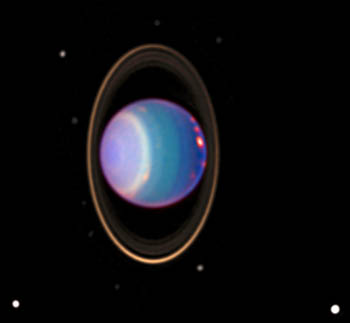One of the enduring mysteries of our solar system is why Uranus is tilted over on its side. If you measure the angle of a planet’s rotation axis (the location of its north pole) compared to the plane of its orbit, you find that all the planets in the solar system are tipped. Jupiter is only 3°, but Earth is at a healthy 23° angle; Mars is too. Venus is tipped so far over it’s essentially upside-down (we know this because it spins the wrong way).
 Uranus, weirdly, is at 98°, like it’s rolling around the outer solar system on its side. The best guess is that it got hit hard by something planet-sized long ago, knocking it over (though there are other, more speculative, ideas). The problem with that is that its moons and rings all orbit around its equator, meaning their orbital planes are tipped as well. It’s hard to see how that might have happened, even if you assume the moons formed in that collision (as, apparently, our Moon formed in an ancient grazing impact with Earth by a Mars-sized body).
Uranus, weirdly, is at 98°, like it’s rolling around the outer solar system on its side. The best guess is that it got hit hard by something planet-sized long ago, knocking it over (though there are other, more speculative, ideas). The problem with that is that its moons and rings all orbit around its equator, meaning their orbital planes are tipped as well. It’s hard to see how that might have happened, even if you assume the moons formed in that collision (as, apparently, our Moon formed in an ancient grazing impact with Earth by a Mars-sized body).
Well, a team of astronomers have come up with a new idea: maybe Uranus wasn’t hit by one big object. Maybe it was hit by two smaller ones.
It would’ve happened when the planet was still forming, and surrounded by a disk of leftover material that was in the process of forming its moons. A proto-planet could’ve hit it, knocking it over somewhat, and sending up a vast cloud of debris that puffed the disk up into a torus (that’s what us scientist-types call a donut). A second collision some time later would’ve completed the task. After more time elapsed things settled down and Uranus would’ve been rotating sideways, and the torus would’ve flattened back into a disk aligned with Uranus’ equator due to tidal forces.
It’s an interesting, if surprising idea. If there were only one collision at that time, the astronomers found the dynamics would’ve made the moons orbit the planet the wrong way (retrograde, against the spin of the planet). It would’ve taken a second hit to add enough momentum to the debris disk to get the moons orbiting prograde.
I wonder if this would also somehow explain the weird magnetic field of Uranus. It’s not aligned at all with the rotation axis, and is even off-center from the core of the planet! It’s unclear why this might be, though it may have to do with Uranus being an ice giant (PDF), with a different composition and structure than Jupiter and Saturn, the two gas giants. I’ll note Earth’s magnetic field isn’t well aligned with our spin axis either, but at least it has the courtesy to be centered on the center of our planet! One idea I’ve seen is that the magnetic field of Uranus isn’t generated in its core, like ours is (or, to be more accurate, in the outer layer of our core – this stuff gets complicated pretty quickly), but might be created higher up in the interior. Clearly, there’s a lot left to figure out here.
All of these things are clues to Uranus’ origin and evolution, its history. The characteristics we see today had some cause, and by piecing all this together we can, perhaps, understand the story of this giant planet. And we need to sometimes entertain unusual ideas – as long as the science supports them – because if there’s one thing that’s usual about the bodies inhabiting the solar system, it’s that they’re unusual.
Image credit: Erich Karkoschka (University of Arizona) and NASA
Related posts:
- Did Herschel see the rings of Uranus?
- Ooo-RAN-us
- Yes, yes, rings around Uranus, haha
- A new ring around Uranus (and this followup)